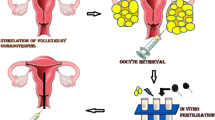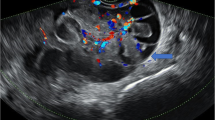Abstract
Since the advent of assisted reproductive technology (ART), the utilization of ART procedures has become increasingly popular among women seeking to establish pregnancy. Radiologists are therefore likely to encounter the various complications of ART therapy. The most common is ovarian hyperstimulation syndrome; others are multiple, ectopic, and heterotopic pregnancies. Ultrasonography is considered the initial modality to investigate ART complications, However, nonspecific symptoms might need the use of an additional imaging modality, such as computed tomography or magnetic resonance imaging, as a problem-solving tool. This article briefly discusses the steps involved in assisted reproduction. Its aim is to help radiologists become familiarized with the multimodality imaging features of the spectrum of ART-related complications. Their key imaging features and differential considerations are emphasized. This will facilitate the provision of precise and timely diagnoses, and aid the avoidance of fatal consequences.
Graphic abstract
















Similar content being viewed by others
References
Kawwass J, Badell M. Maternal and feral risk associated with assisted reproductive technology. Obstet Gynecol 2018; 132(3): 763–72
Gelbaya TA. Short and long-term risks to women who conceive through in vitro fertilization. Hum Fertil (Camb) 2010;13(1):19–27.
Sunderam S, Kissin D, Crawford S. Assisted reproductive technology surveillance—United States. MMWR Fertil Steril Summ 2018; 67:1–28.
Balen A, Morley L, Misso M. The management of anovulatory infertility in women with polycystic ovarian syndrome: an analysis of the evidence to support the development of global WHO guidance. Hum Reprod 2016;22(6):687–708.
Kawwass J, Kissin D, Kulkarni A, Creanga AA, Session DR, Callaghan WM, Jamieson DJ, National ART Surveillance System (NASS) Group (2015) Safety of assisted reproductive technology in the United States, 2000–2011. JAMA;2015 313:88–90.
Singh AK, Desai H, Novelline RA. Emergency MRI of acute pelvic pain: MR protocol with no oral contrast. Emerg Radiol 2009; 16:133–41.
Dohke M, Watanabe Y, Okumura A, Amoh Y, Hayashi T, Yoshizako T, et al. Comprehensive MR Imaging of Acute Gynecologic Diseases. Radiographics 2000;2:1551–66.
Klemetti R, Sevón T, Gissler M, Hemminki E. Complications of IVF and ovulation induction. Hum Reprod 2005;20(12):3293–300.
Zivi E, Simon A, Laufer N. Ovarian hyperstimulation syndrome: definition, incidence, and classification. Semin Reprod Med 2010;28(6):441–7.
Kashyap S, Parker K, Cedars M, Rosenwaks Z Ovarian hyperstimulation syndrome prevention strategies: reducing the human chorionic trigger dose. Semin Reprod Med 2010; 28:475–85
Tandulwadkar SR, Lodha PA, Mangeshikar NT. Obstetric complications in women with IVF conceived pregnancies and polycystic ovarian syndrome. J Hum Reprod Sci 2014; 7:13–18
Schenker J. Prevention and treatment of ovarian hyperstimulation syndrome. Hum Reprod 1993;8:653–9.
Lyons CA, Wheeler CA, Frishman GN, Hackett RJ, Seifer DB, Haning RV Jr. Early and late presentation of the ovarian hyperstimulation syndrome: two distinct entities with different risk factors. Hum Reprod 1994; 9(5):792–9.
Gat I, Shlush E, Quach K, Librach CL. Librach. The continuum of high ovarian response: a rational approach to the management of high responder patient subgroup. Syst Biol Reprod Med 2015;61(6):336–44
Humaidan P, Nelson SM, Devroey P, Coddington CC, Schwartz LB, Gordon K, et al. Ovarian hyperstimulation syndrome: review and new classification criteria for reporting in clinical trials. Human Reproduction 2016 31(9):1997–2004
Saha PK. Ovarian Hyperstimulation Syndrome (OHSS) Presented as Massive Hydrothorax. J Clin Diagn Res 2013; 7(12):2996–7.
Jung SE, Byun JY, Lee JM. MR imaging of maternal diseases in pregnancy. AJR Am J Roentgenol 2001;177(6):1293–300.
Jung BG, Kim H. Severe spontaneous ovarian hyperstimulation syndrome with MR findings. J Comput Assist Tomogr 2001;25(2):215–7.
Bennett GL, Slywotzky CM, Giovanniello G. Gynecologic causes of acute pelvic pain: spectrum of CT findings. RadioGraphics 2002;22(4):785–801.
Maxwell K, Cholst I, Rosenwaks Z. The incidence of both serious and minor complications in young women undergoing oocyte donation. Fertil Steril 2008;90(6):2165–71.
Cerrillo M, Pacheco A, Rodriguez S. Effect of GnRH agonist and hCG treatment on VEGF, angiopoietin-2, and VE-cadherin: trying to explain the link to ovarian hyperstimulation syndrome. Fertil Steril 2011;95:2517–9.
Badeeb A, Brook A, Lee KS. Dark cortical rim: an MRI feature of polycystic ovarian syndrome. Abdominal Radiology 2021;46:1148–56.
Castelo-Branco C, del Pino M, Valladares E. Ovarian hyperstimulation, hyperprolactinaemia and LH gonadotroph adenoma. Reprod Biomed Online. 2009;19(2):153–5.
Emami MHH, Langroudi RM. Ovarian hyperstimulation syndrome and autoimmune primary hypothyroidism in two members of a family. J Clin Case Reports. 2012;02(04):2–4.
Delbaere A, Smits G, De Leener A. Understanding ovarian hyperstimulation syndrome. Endocrine. 2005;26(3):285–90.
Mittal K, Koticha R, Dey AK, Anandpara K, Agrawal R, Sarvothaman MP, Thakkar H. Radiological Illustration of Spontaneous Ovarian Hyperstimulation Syndrome. Pol J Radiol 2015; 80:217–27.
Mashiach S, Bider D, Moran O, Goldenberg M, Ben-Rafael Z. Adnexal torsion of hyperstimulated ovaries in pregnancies after gonadotropin therapy. Fertil Steril 1990;53(1):76–80.
Wilkinson C, Sanderson A. Adnexal torsion—a multimodality imaging review. Clin Radiol 2012;67(5):476–483
Arena S, Canonico S, Luzi G, Epicoco G, Brusco GF, Affronti G. Ovarian torsion in in vitro fertilization-induced twin pregnancy: combination of Doppler ultrasound and laparoscopy in diagnosis and treatment can quickly solve the case. Fertil Steril 2009;92(4):1496.e9–13.
Chang HC, Bhatt S, Dogra VS. Pearls and pitfalls in diagnosis of ovarian torsion. RadioGraphics 2008; 28(5):1355–68.
Huchon C, Fauconnier A. Adnexal Torsion: A Literature Review. Journal of Obstetrics & Gynecology and Reproductive Biology 2010; 150, 8–12.
Roest J, Mous HV, Zeilmaker GH, Verhoeff A. The incidence of major clinical complications in a Dutch transport IVF programme. Hum Reprod Update 1996;2(4):345–53.
Kim IY, Lee BH. Ovarian hyperstimulation syndrome: US and CT appearances. Clin Imaging 1997;21(4):284–6.
Graif M, Shalev J, Strauss S, Engelberg S, Mashiach S, Itzchak Y. Torsion of the ovary: sonographic features. AJR Am J Roentgenol 1984;143(6): 1331–4.
Bar-On S, Mashiach R, Stockheim D. Emergency laparoscopy for suspected ovarian torsion: are we too hasty to operate? Fertil Steril 2010;93(6): 2012–5.
Fleischer AC, Stein SM, Cullinan JA, Warner MA. Color Doppler sonography of adnexal torsion. J Ultrasound Med. 1995 Jul; 14(7): 523–8.
Bennett SJ, Waterstone JJ, Cheng WC, Parsons J. Complications of transvaginal ultrasound-directed follicle aspiration: a review of 2670 consecutive procedures. J Assist Reprod Genet 1993;10(1):72–7.
Sarhan A, Muasher SJ. Surgical complications of in vitro fertilization. Middle East Fertil Soc J 2007;12(1) 1–7.
Azem F, Wolf Y, Botchan A, Amit A, Lessing J B, Kluger Y. Massive retroperitoneal bleeding: a complication of transvaginal ultrasonography-guided oocyte retrieval for IVF-ET. Fertility and Sterility 2000; 74, 405–6.
Bennett S. J, Waterstone J. J, Cheng W. C, Parsons J. Complications of transvaginal ultrasound-directed follicle aspiration: a review of 2670 consecutive procedures. Journal of Assisted Reproduction and Genetics 1993;10, 772–8.
Dicker D, Ashkenazi J, Feldberg D, Levy T, Dekel A, Ben-Rafael Z. Severe abdominal complications after transvaginal ultrasonographically guided retrieval of oocytes for IVF & ET. Fertility and Sterility 1993;59, 1313–5.
Jones, W. R., Haines, C. J., Matthews, C. D., & Kirby, C. A Traumatic ureteric obstruction secondary to oocyte recovery for IVF: a case report. Journal of In Vitro Fertilization and Embryo Transfer 1985; 6, 185–7.
Salem A El-Shawarby, Raul A Margara, Geoffrey H Trew & Stuart A Lavery. A review of complications following transvaginal oocyte retrieval for in-vitro fertilization, Human Fertility 2004; 7:2, 127–33.
Evers JLH, Larsen JF, Gnany GG, Seick UV. Complications and problems in transvaginal sector scan-guided follicle aspiration. Fertil Steril 1988;49:278–82
Anuradha Rao. Potential imaging findings following assisted reproduction: complications and clinical implications. Emerg Radiol 2018; 25:73–86.
Fernandez H, Gervaise A. Ectopic pregnancies after infertility treatment: modern diagnosis and therapeutic strategy. Hum Reprod Update 2004; 10:503–13.
Chang H, Suh C. Ectopic pregnancy after assisted reproductive technology: what are the risk factors? Curr Opin Obstet Gynecol 2010;22:202–7.
Farquhar C. Ectopic pregnancy. Lancet 2005;366:583–91.
Clayton H, Schieve L, Peterson H. Ectopic pregnancy risk with assisted reproductive technology procedures. Obstet Gynecol 2006;107:595–604.
Perkins K, Boulet S, Kissin D, Jamieson DJ. National ART Surveillance (NASS) Group. Risk of ectopic pregnancy associated with assisted reproductive technology in the United States; 2001–2011. Obstet Gynecol 2015;125(1):70–8.
Dor J, Seidman D, Levran D. The incidence of combined intrauterine and extrauterine pregnancy after in vitro fertilization and embryo transfer. Fertil Steril 1991;55:833–4.
Levine D. Ectopic pregnancy. Radiology 2007;245(2):385–97.
Brown D, Doubilet P.Transvaginal sonography for diagnosing ectopic pregnancy: positivity criteria and performance characteristics. J Ultrasound Med 1994; 13(4):259–66.
Kao LY, Scheinfeld MH, Chernyak V, Rozenblit AM, Oh S, Dym RJ. Beyond ultrasound: CT and MRI of ectopic pregnancy. AJR Am J Roentgenol 2014; 202:904–11.
Kanal E, Shellock FG. Safety manual on magnetic resonance imaging contrast agents. Cedar Knolls, NJ: Lippincott-Raven Healthcare, 1996.
Shellock FG, Kanal E. Safety of magnetic resonance imaging contrast agents. J Magn Reson Imaging 1999;10(3):477–84.
E. Mausner Geffen , C. Slywotzky, G. Bennett. Pitfalls and tips in the diagnosis of ectopic pregnancy. Abdom Radiol 2017;42:1524–42
Greenberg JA. Bilateral ectopic pregnancy. Rev Obstet Gynecol 2008;1(2):48.
Kasum M, Grizelj V, Simunic V. Simultaneous bilateral tubal pregnancy following in-vitro fertilization and embryo transfer. Hum Reprod 1998;13(2): 465–7.
De Los Ríos JF, Castañeda JD, Miryam A. Bilateral ectopic pregnancy. J Minim Invasive Gynecol 2007; 14(4):419–27.
Rojansky N, Schenker J. Heterotopic pregnancy and assisted reproduction: an update. J Assist Reprod Genet 1996; 13(7):594–601.
Elizabeth H. Dibble, Ana P. Lourenco. Imaging Unusual Pregnancy Implantations: Rare Ectopic Pregnancies and More AJR 2016; 207:1380–92.
Talbot K, Simpson R, Price N, Jackson SR. Heterotopic pregnancy. J Obstet Gynaecol 2011; 31:7–12.
Benjamin Hirshberg, Matthew Rheinboldt. Multimodality imaging of acute locoregional and systemic complications in the setting of assisted reproduction. Emergency Radiology 2019;26:205–19.
O. Dundar, L Tutuncu, E. Mungen, M. Muhcu, Y. Z. Yergok: Heterotopic pregnancy: tubal ectopic pregnancy and monochorionic mono-amniotic twin pregnancy: a case report, Perinatal journal. 2006; 14:96–100.
Sitthipong Srisajjakul, Patcharin Prapaisilp, Sirikan Bangchokdee. Magnetic resonance imaging in tubal and nontubal ectopic pregnancy. European Journal of Radiology 2017; 93:76–89.
Chan W, Dixon M. The ‘ART’ of thromboembolism: a review of assisted reproductive technology and thromboembolic complications. Thromb Res 2008;121:713–26.
Chan W, Ginserg J. A review of upper extremity deep vein thrombosis in pregnancy: unmasking the ‘ART’ behind the clot. J Thromb Haemost 2006;4:1673–7.
Grandone E, Villani M. Assisted reproductive technologies and thrombosis. Thrombosis Res 2015;135:S34–S45.
Serour G, Aboulghar M, Mansour R. Complications of medically assisted conception in 3500 cycles. Fertil Steril 1998;70:638–42.
Bauersachs R, Manolopoulos K, Hoppe I. More on: the “ART” behind the clot: solving the mystery. J Thrmb Haemost 2007;5(2):438–9.
Author information
Authors and Affiliations
Corresponding author
Ethics declarations
Conflict of interest
The authors hereby declare no personal or professional conflicts of interest regarding any aspect of this article.
Additional information
Publisher's Note
Springer Nature remains neutral with regard to jurisdictional claims in published maps and institutional affiliations.
Rights and permissions
About this article
Cite this article
Srisajjakul, S., Prapaisilp, P. & Bangchokdee, S. Imaging of complications following treatment with assisted reproductive technology: keep on your radar at each step. Abdom Radiol 47, 328–340 (2022). https://doi.org/10.1007/s00261-021-03245-y
Received:
Revised:
Accepted:
Published:
Issue Date:
DOI: https://doi.org/10.1007/s00261-021-03245-y




